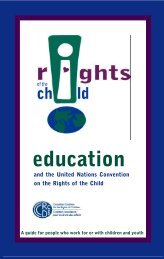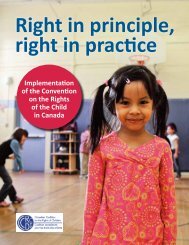Poste - Canadian Coalition for the Rights of Children
Poste - Canadian Coalition for the Rights of Children
Poste - Canadian Coalition for the Rights of Children
You also want an ePaper? Increase the reach of your titles
YUMPU automatically turns print PDFs into web optimized ePapers that Google loves.
C A N A D I A N C O A L I T I O N F O R T H E R I G H T S O F C H I L D R E N<br />
• a lack <strong>of</strong> clear goals <strong>for</strong> child abuse prevention and<br />
inadequate services <strong>for</strong> high risk families;<br />
• serious delays in case planning and few<br />
individualized service plans <strong>for</strong> children in care;<br />
• poor permanency planning <strong>for</strong> children who cannot<br />
return to <strong>the</strong>ir families;<br />
• a lack <strong>of</strong> reliable in<strong>for</strong>mation <strong>for</strong> managers;<br />
• a need <strong>for</strong> reliable, independent reviews <strong>of</strong> ongoing<br />
interventions;<br />
• inadequate training and upgrading <strong>for</strong> pr<strong>of</strong>essionals;<br />
• an under-utilization <strong>of</strong> clinical diagnostic and risk<br />
assessment tools;<br />
• fragmented and uncoordinated services <strong>for</strong> children<br />
and youth;<br />
• few support services <strong>for</strong> foster families; and<br />
• uneven allocation <strong>of</strong> resources among <strong>the</strong> regions. 28<br />
Failures <strong>of</strong> Child Protection<br />
Systems<br />
A key challenge <strong>for</strong> child welfare workers is deciding<br />
when a child should be taken into care and when a child<br />
would best be served by staying in <strong>the</strong> family home, with<br />
services and supports provided to <strong>the</strong> parents. 29 Bruce<br />
Rivers, executive director <strong>of</strong> <strong>the</strong> <strong>Children</strong>’s Aid Society<br />
<strong>of</strong> Toronto, says that when Ontario’s child welfare<br />
legislation was changed in 1984, it became more difficult<br />
to separate at-risk children from <strong>the</strong>ir parents. “The<br />
overriding emphasis [was] on maintaining <strong>the</strong> autonomy<br />
and integrity <strong>of</strong> <strong>the</strong> family.” 30 Currently, <strong>the</strong> focus on<br />
family preservation is losing ground in most jurisdictions<br />
to a renewed emphasis on protection <strong>of</strong> <strong>the</strong> child. This<br />
shift in focus has been fueled in part by child death<br />
reviews highlighting tragic failures <strong>of</strong> child welfare<br />
systems.<br />
The Gove Inquiry, British Columbia<br />
In 1995, <strong>the</strong> British Columbia Gove Inquiry into Child<br />
Protection told Mat<strong>the</strong>w Vaudreuil’s story. Mat<strong>the</strong>w was<br />
almost six years old when he was killed by his mo<strong>the</strong>r.<br />
Throughout Mat<strong>the</strong>w’s short life, he was a client <strong>of</strong> <strong>the</strong><br />
Ministry <strong>of</strong> Social Services, under <strong>the</strong> responsibility <strong>of</strong><br />
21 different social workers and seen by doctors 75 times.<br />
Yet he was not protected, “not by his mo<strong>the</strong>r, not by his<br />
community and not by those charged with protecting<br />
British Columbia’s children.” 31<br />
The Gove Inquiry went beyond Mat<strong>the</strong>w’s death to<br />
review <strong>the</strong> entire child protection system in <strong>the</strong> province<br />
and resulted in 118 recommendations <strong>for</strong> change. The<br />
44<br />
inquiry found that social workers were confused about<br />
<strong>the</strong>ir role and two-thirds <strong>of</strong> <strong>the</strong>m had no pr<strong>of</strong>essional<br />
social work qualifications. Files were not reviewed,<br />
reports discounted, pr<strong>of</strong>essional risk assessments not<br />
done, case plans were disjointed, files disorganized or<br />
incorrect, and <strong>the</strong>re was no complaint process <strong>for</strong><br />
clients. 32<br />
Judge Gove found that “<strong>for</strong> as long as anyone can<br />
remember,” child protection had been conducted in<br />
secrecy, that <strong>the</strong> system in British Columbia was<br />
fundamentally flawed and that a new one needed to be<br />
developed. 33<br />
Inquests and Reviews, Ontario<br />
Child welfare re<strong>for</strong>m in Ontario has been fueled by<br />
recommendations from recent public inquests and<br />
inquiries into <strong>the</strong> deaths <strong>of</strong> children who were killed by<br />
<strong>the</strong>ir parents. In 1996, <strong>the</strong> Ontario Association <strong>of</strong><br />
<strong>Children</strong>’s Aid Societies (OACAS) and <strong>the</strong> province’s<br />
Coroner’s Office <strong>for</strong>med <strong>the</strong> Ontario Child Mortality<br />
Task Force to review <strong>the</strong> deaths between 1994 and 1995<br />
<strong>of</strong> children receiving child welfare services. The Coroner<br />
also initiated eight inquests into <strong>the</strong> deaths <strong>of</strong> children<br />
known to children’s aid societies (CASs).<br />
The Child Mortality Task Force and <strong>the</strong> inquest juries<br />
made more than 400 recommendations on a range <strong>of</strong><br />
child protection issues, including revisions to <strong>the</strong> Child<br />
and Family Services Act (CFSA) to broaden <strong>the</strong> grounds<br />
<strong>for</strong> finding a child in need <strong>of</strong> protection.<br />
The government struck a panel <strong>of</strong> experts on child<br />
protection to review <strong>the</strong> CFSA. In March 1998, <strong>the</strong> panel<br />
detailed its recommendations in Protecting Vulnerable<br />
<strong>Children</strong>. The main changes to <strong>the</strong> CFSA called <strong>for</strong> by<br />
<strong>the</strong> panel include: 34<br />
• a clear statement that <strong>the</strong> legislation’s focus is<br />
protecting <strong>the</strong> safety, well-being and best-interests <strong>of</strong><br />
children;<br />
• <strong>the</strong> inclusion <strong>of</strong> a definition <strong>of</strong> neglect;<br />
• more focus on <strong>the</strong> characteristics, past conduct and<br />
behaviour <strong>of</strong> <strong>the</strong> caregivers when determining <strong>the</strong> risk<br />
to a child;<br />
• a less onerous test <strong>of</strong> risk <strong>of</strong> harm;<br />
• ensuring that key concepts in <strong>the</strong> legislation are<br />
more consistently interpreted;<br />
• reducing lengthy delays in decision-making<br />
processes; and<br />
• clarifying <strong>the</strong> duty to report and <strong>for</strong> in<strong>for</strong>mationsharing.




